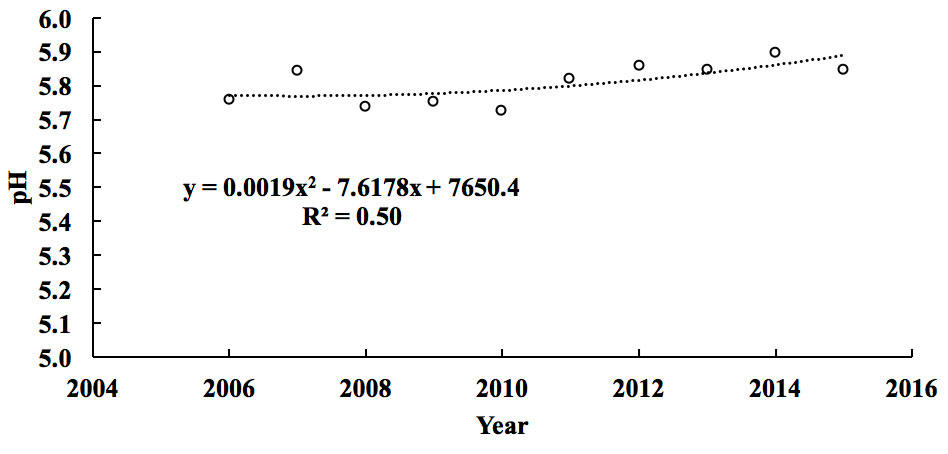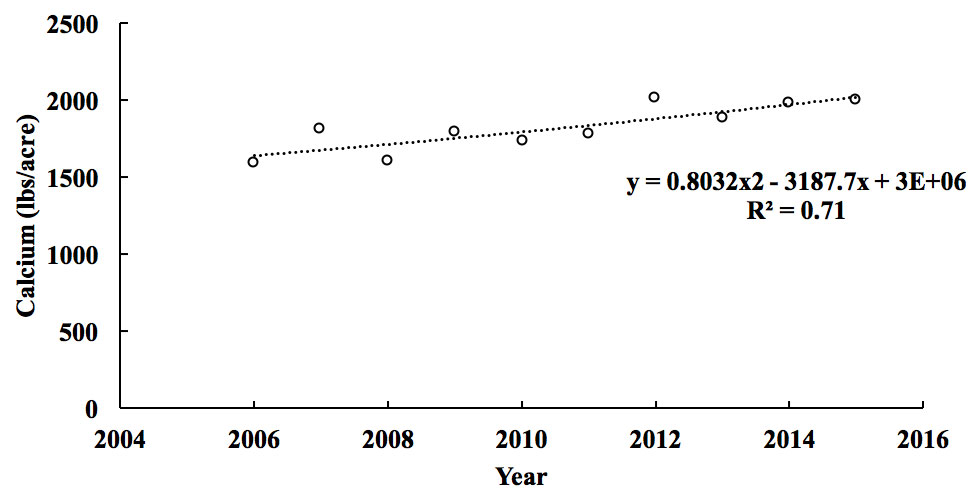Bulletin #1085, Potato Farmers in Aroostook County, Maine, Should Test for Soil pH and Calcium and Correct as Needed
Developed by Lakesh Sharma, University of Maine Cooperative Extension Assistant Professor of Sustainable Agriculture, and Sukhwinder Bali, Assistant Professor of Sustainable Agriculture, University of Maine Cooperative Extension
For information about UMaine Extension programs and resources, visit extension.umaine.edu.
Find more of our publications and books at extension.umaine.edu/publications/.
Why soil pH matters to Aroostook County potato farmers:
Soil pH strongly influences the availability of soil nutrients to plants. The soils of New England tend to be acidic, so farmers long tried to maintain a low soil pH to protect potatoes from scab issues. More recently, with the release of the scab-resistant potato variety Russet Burbank, which is now commonly planted in Aroostook County, farmers growing Russet Burbank no longer maintain low pH. In fact, they are growing quality grains due to improved soil pH.
What was done:
UMaine Extension analyzed data from soils sampled from Aroostook County between 2006 and 2015 to determine the pH and Ca levels in the rooting zone. Each year, mostly in spring and autumn, farmers and home gardeners send soil samples to the UMaine Soil Lab. The lab processes an average of ~1,100 potato soil samples yearly. The lab provides chemical analysis and fertilizer recommendations relevant to the intended crop. Soil samples were taken from segregated areas of Russet Burbank potatoes.
Recommended soil pH for potatoes:
The UMaine Cooperative Extension guideline for optimum soil test pH for potatoes is 5.5–6.5.
pH results:1
Aroostook County, Maine’s, soil pH has been increasing over the last 10 years (Figure 2). The soil pH has increased due to farmers’ interest in crop rotation of grains that require a higher pH, and the switch from white potato varieties to scab-resistant Russet Burbank varieties.

The potato nutrient recommendations in Maine were developed when the average soil pH was 5 (20 years ago). The pH is now almost 6 and is expected to continue to increase due to emphasis on grain rotation with potatoes and scab-resistant varieties.
Why is soil pH changing?
The observed pH changes could be due to two important factors. First, growers apply lime in grain years to raise soil pH and to counteract high N application as ammonium sulfate (70% of farmers apply ammonium sulfate as the source of N). Ammonium sulfate is three times more acidic than other N fertilizers applied in potato years.2 Second, the residual effect of N applied during potato years is left in the soil during grain years and reduces the soil pH. Lime application was demonstrated to increase Ca levels in the soil every year (R2 = 0.39). The soil pH could also change with long-term excessive fertilization practices.3
Why soil Ca matters to Aroostook County potato farmers:
Ca helps in the development of strong potato skin, which ultimately produces less bruising to potatoes during harvesting. Because potato cultivation in Aroostook County is rain-fed and harvesting happens under dry conditions, having a strong skin on potatoes is especially important.
Recommended soil Ca for potatoes:
The UMaine Cooperative Extension guideline for optimum soil test Ca for potatoes is 60–80% saturation.
Ca results:
Ca was at a maximum in the soil in 2012 and at a minimum in 2006. The correlation between soil Ca and crop type was significant (R2 = 0.71). In potato years, the R2 was 0.39 because growers apply lime in grain years to impact potato years, but it takes 2–3 years for lime to raise soil pH and in the second grain year the soil pH is higher.
Effect of pH on Ca and other nutrients:
The changes in soil pH range raise a legitimate question about whether new nutrient recommendations for potato are necessary due to the effect of pH on available nutrientsMaine’s nutrient recommendations are almost 20 years old.
Conclusion:
Figure 2 represents rooting zone soil pH for an average of ~1,100 soil samples from Aroostook County each year between 2006 and 2015. The distribution and correlation value (R2 = 0.50) confirm that the increase in soil pH was gradual. Similarly, the increase in the level of soil Ca (Figure 3), with a significant coefficient of correlation (R2 = 0.71), confirmed that farmers applied lime to improve their soil pH.

The take-home message of this study for growers is that with increased soil pH, nutrient availability has improved, so growers might consider cutting back their additions of major nutrients, especially phosphorus. High Ca has a positive impact on potato quality and farmers have shown strong interest in improving its availability in soil. This could lead to the development of a potential high-value rotation crop such as malt barley.
For more information, contact:
Lakesh Sharma, Soil Specialist
Assistant Professor, Extension and Sustainable Agriculture
University of Maine Cooperative Extension, Presque Isle Office
57 Houlton Road
Presque Isle, Maine 04769
Office Phone: 207.764.3361
Fax: 207.764.3362
Cell: 207.498.0316
lakesh.sharma@maine.edu
Lakesh Sharma Staff Directory Listing
1 Note that the results discussed throughout this publication are for the average of all relevant soil tests submitted. Before applying amendments to any field, you should submit a soil test to the UMaine Soil Lab and follow the recommendations based specifically on your results. This fact sheet is intended to alert potato farmers in Aroostook County, Maine, of potential nutrient issues with their soils.
2 Cheng, H. T. 2005. Competitive relationships among potato production areas in northeastern America. Journal of Food Distribution Research 36: 27–32.
3 DeVries, W., and A. Breeuwsma. 1987. The relationship between soil acidification and element cycling. Water Air and Soil Pollution 35: 293–310; McCarthy, J. J., O. F. Canziani, N. A. Leary, D. J. Dokken, and K. S. White. 2001. Climate Change 2001: Impacts, Adaptation, and Vulnerability: Contribution of Working Group II to the Third Assessment Report of the Intergovernmental Panel on Climate Change. Cambridge University Press, Cambridge, UK.
Information in this publication is provided purely for educational purposes. No responsibility is assumed for any problems associated with the use of products or services mentioned. No endorsement of products or companies is intended, nor is criticism of unnamed products or companies implied.
© 2018
Call 800.287.0274 (in Maine), or 207.581.3188, for information on publications and program offerings from University of Maine Cooperative Extension, or visit extension.umaine.edu.
The University of Maine is an EEO/AA employer, and does not discriminate on the grounds of race, color, religion, sex, sexual orientation, transgender status, gender expression, national origin, citizenship status, age, disability, genetic information or veteran’s status in employment, education, and all other programs and activities. The following person has been designated to handle inquiries regarding non-discrimination policies: Sarah E. Harebo, Director of Equal Opportunity, 101 North Stevens Hall, University of Maine, Orono, ME 04469-5754, 207.581.1226, TTY 711 (Maine Relay System).

